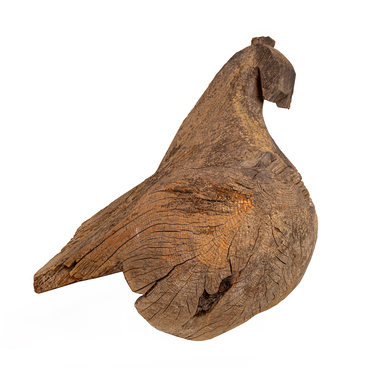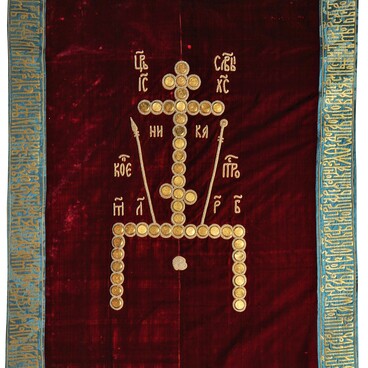The golden riza of the icon “Holy Trinity” by Andrei Rublev was made and set by the order of the Tsar Boris Godunov in 1599. The “Godunov” icon riza includes a frame with images of saints (including the heavenly patrons of the Godunov family), a “light” in the form of gold sheets with an elegant ornament covering the background of the icon in the upper part, and three luxurious metal adornment covering the halo of an icon, which are decorated with a large number of gems.
In the central crown, among the precious stones, there is a hexagonal emerald with a relief image of the Holy Trinity in the form of three angels sitting at a table. This cameo was supposedly made by the Venetian master Francesco Ascentini.
The son of Boris Godunov, Tsarevich Fyodor Borisovich, in 1601 supplemented the riza with three gold panagia-pendants, of which one has been preserved. Nowadays it is attached to the image of the central angel. On the front side of the panagia there is a Byzantine cameo of the 11th century with a half-length image of the Christ Pantocrator. The image is carved on a sapphirine, a semi-precious mineral of light blue color. The “tsatas” — inverted crescent-shaped necklaces on the figures — were created in 1626 in Moscow by German masters Gast Jakub and Lent Yan at the commission of the Tsar Mikhail Romanov.
The final composition of the riza dates back to 1754. It was then that the silver gilded riza, made in Moscow by the master Ivan Grigoriev at the expense of the monastic treasury, covered the entire central part of the icon, with the exception of places depicting the faces, hands and feet of angels.
The icon “Holy Trinity” by Andrei Rublev was the most revered image of the largest monastery in Russia —the Trinity-St. Sergius Monastery, so they created such a luxurious covering for it. The icon riza was separated from the icon in 1918. The image itself has been kept in the State Tretyakov Gallery since 1929.
Andrey Rublev is a Russian icon painter of the 15th century. He was born presumably in 1360. The first mention of Rublev in the chronicle appeared only in 1405. It testified that Theophanes the Greek, Prokhor the elder and the chernets (monk) Andrei Rublev painted the Annunciation Cathedral in the Moscow Kremlin.
In the central crown, among the precious stones, there is a hexagonal emerald with a relief image of the Holy Trinity in the form of three angels sitting at a table. This cameo was supposedly made by the Venetian master Francesco Ascentini.
The son of Boris Godunov, Tsarevich Fyodor Borisovich, in 1601 supplemented the riza with three gold panagia-pendants, of which one has been preserved. Nowadays it is attached to the image of the central angel. On the front side of the panagia there is a Byzantine cameo of the 11th century with a half-length image of the Christ Pantocrator. The image is carved on a sapphirine, a semi-precious mineral of light blue color. The “tsatas” — inverted crescent-shaped necklaces on the figures — were created in 1626 in Moscow by German masters Gast Jakub and Lent Yan at the commission of the Tsar Mikhail Romanov.
The final composition of the riza dates back to 1754. It was then that the silver gilded riza, made in Moscow by the master Ivan Grigoriev at the expense of the monastic treasury, covered the entire central part of the icon, with the exception of places depicting the faces, hands and feet of angels.
The icon “Holy Trinity” by Andrei Rublev was the most revered image of the largest monastery in Russia —the Trinity-St. Sergius Monastery, so they created such a luxurious covering for it. The icon riza was separated from the icon in 1918. The image itself has been kept in the State Tretyakov Gallery since 1929.
Andrey Rublev is a Russian icon painter of the 15th century. He was born presumably in 1360. The first mention of Rublev in the chronicle appeared only in 1405. It testified that Theophanes the Greek, Prokhor the elder and the chernets (monk) Andrei Rublev painted the Annunciation Cathedral in the Moscow Kremlin.



